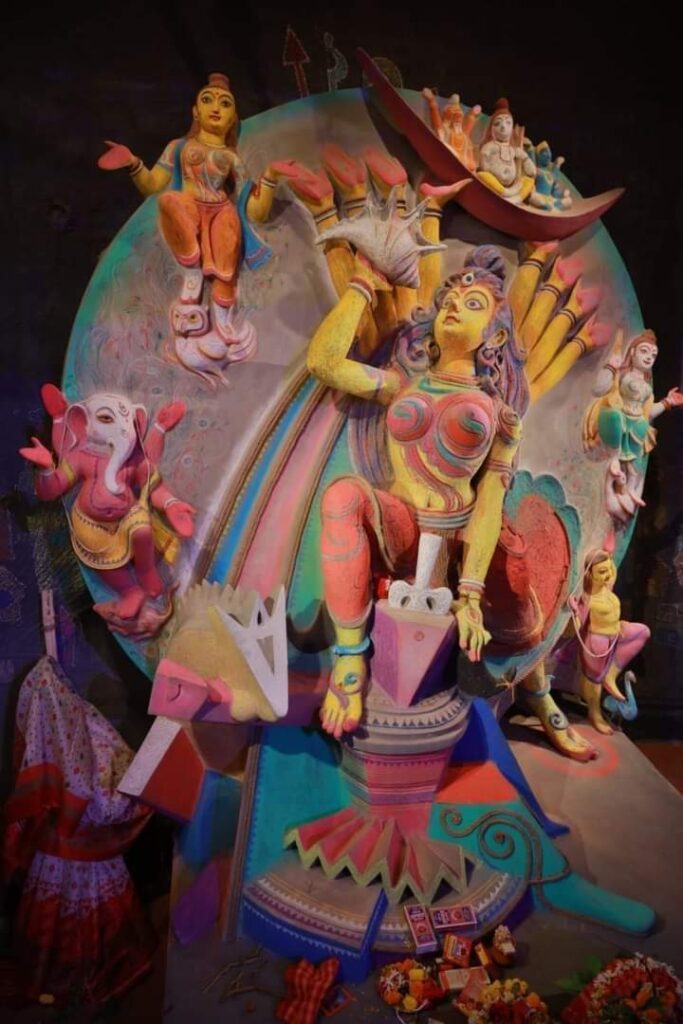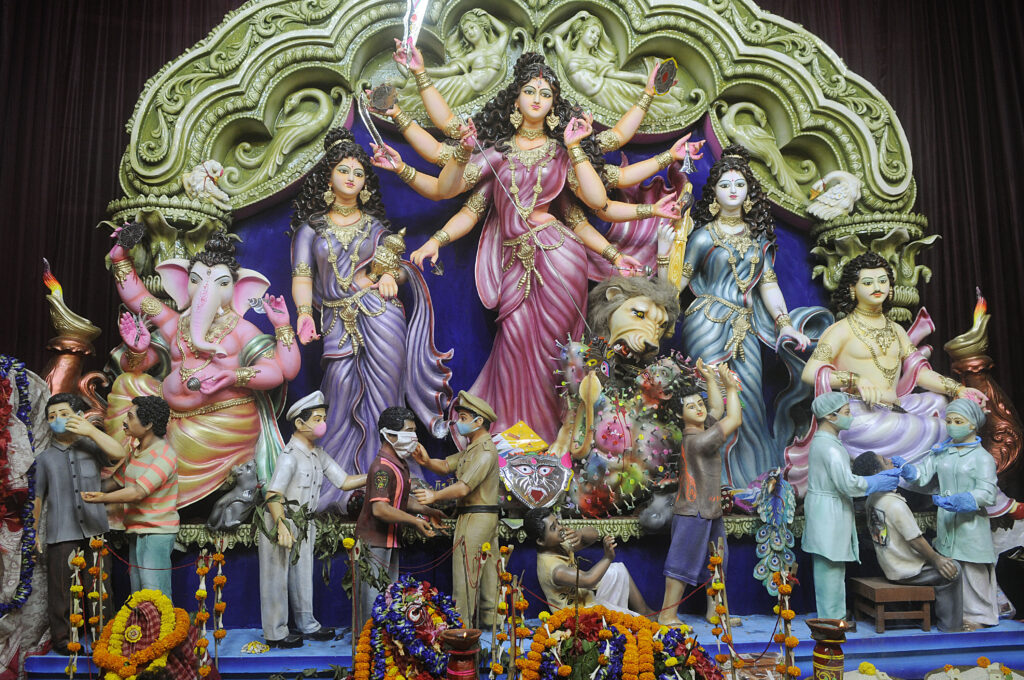
Durga Puja is eastern India’s biggest festival that is held with much pomp in the states of West Bengal, Bihar, Assam, and Odisha every year. This autumnal festival celebrates the victory of the mother goddess, “Durga,” over “Mahisasura,” the buffalo demon.
In Hindu mythology, the festival heralds the visit of the goddess and her children to her home on earth. During this four-five day period, clay idols of the goddess are worshipped in exquisitely decorated pandals (temporary structures) that showcase the fine craftsmanship of the artisans of this region.
This year, the essence of Durga Puja, which is on till Oct. 26, has been muted because of the ongoing pandemic, but that hasn’t stopped organizers from getting traditional idol-makers to create unique idols of the goddess, many of which have a social message.
Durga Puja in West Bengal is more of a socio-cultural celebration than a religious affair. They are called barowari (a group of 12 friends) pujas to signify that it has been organized by a group of local people and financed from a common pool.
A community puja was first organized in 1790 by a committee of twelve Brahmins of Guptipara (Hooghly district). Eventually, the festival gained popularity across West Bengal, and what had once been an event for the rich and upper class, became an inclusive collective enterprise.
These days it is a tradition to link social and current issues to the idols and pandals. Puja organizers recreate film sets, famous monuments, or abstract art. This year, clubs and puja committees across the City of Joy demonstrated their concern about the state of the nation due to the pandemic.
This year, migrant laborers, the coronavirus, and the under-construction Ram Mandir (temple) — a pet project of the ruling BJP government at the Centre — have emerged as some of the popular puja themes in West Bengal’s capital city, Kolkata.
Here are five pujas in Kolkata that have caught the attention of visitors.

Naktala Udayan Sangha
South Kolkata’s Naktala Udayan Sangha’s Durga Puja too pays tribute to the migrant workers. Here migrant workers have been likened to clouds that wander from place to place without any destination. A replica of a truck crammed with migrant laborers is at display beside the pandal.
Anjan Das, joint secretary of Naktala Udayan Sangha, claimed that the aim of the club was to portray the pain of an employed person. The pandemic has caused severe job losses in India and unemployment is at an all-time high in the country.
“Everyone is suffering deeply due to the job losses and pay cuts that the pandemic has forced upon us,” said Das. “Lives have been changed drastically and those that have suffered the most are the migrant workers, the factory hands, and farmers. These poverty-stricken people are struggling for existence.”

Mohammed Ali Park
North Kolkata’s Mohammad Ali Park highlights the challenges faced by the Covid-19 frontline warriors. The club has replaced the traditional idol of “Mahisasura” with a “Coronasura” (corona demon). While the main idol of Durga is traditional, idols of policemen and doctors have been incorporated in the tableau to highlight their importance in the fight against Covid-19.

Hatibagan Sarbojonin
North Kolkata’s Hatibagan Sarbojonin has “ashamapto” (unfinished) as its theme. The pandal still has technicians and artists working inside it with hammers and nails scattered all around. The larger message is to show how the world has stopped mid-step due to the pandemic.
The idol and the pandal, made of old newspapers and magazines, are eco-friendly.
Anindya Dasgupta, publicity coordinator from the Hatibagan Sarbojin said to Zenger News, “Life as we knew it has suddenly come to a halt due to the pandemic. Plans, dreams…everything is on hold and our pandal mirrors this sense of incompleteness.”

Balaka Abasan Pujo Committee
New Town’s Balaka Abasan Pujo Committee’s pandal is a replica of the Ram Temple in the north Indian town of Ayodhya. The temple is being built on the site of the 16th-century Babri Masjid (mosque) that was demolished in 1992 by Hindu hardliners. The construction of the temple started in August this year after a grand foundation-laying ceremony by Indian Prime Minister Narendra Modi.

Barisha Club
The Barisha Club Durga Puja, situated in the western part of Kolkata, has a migrant woman as goddess Durga. The idol depicts a woman walking with a shirtless baby in her arms.
The idol is a comment on the plight of hundreds of migrant laborers who were left stranded without food, money, or jobs when the first Covid-19 lockdown was announced in India. Many migrants were forced to trek back to their villages thousands of miles away on foot.
“The pandal has been made out of the jute bags that were used to pack the relief rations for migrant laborers and other waste materials,” said Animesh Chakraborty, a senior member from the Barisha Club.
The post Pandemic Themes Reign at Kolkata Durga Pujas appeared first on Zenger News.
